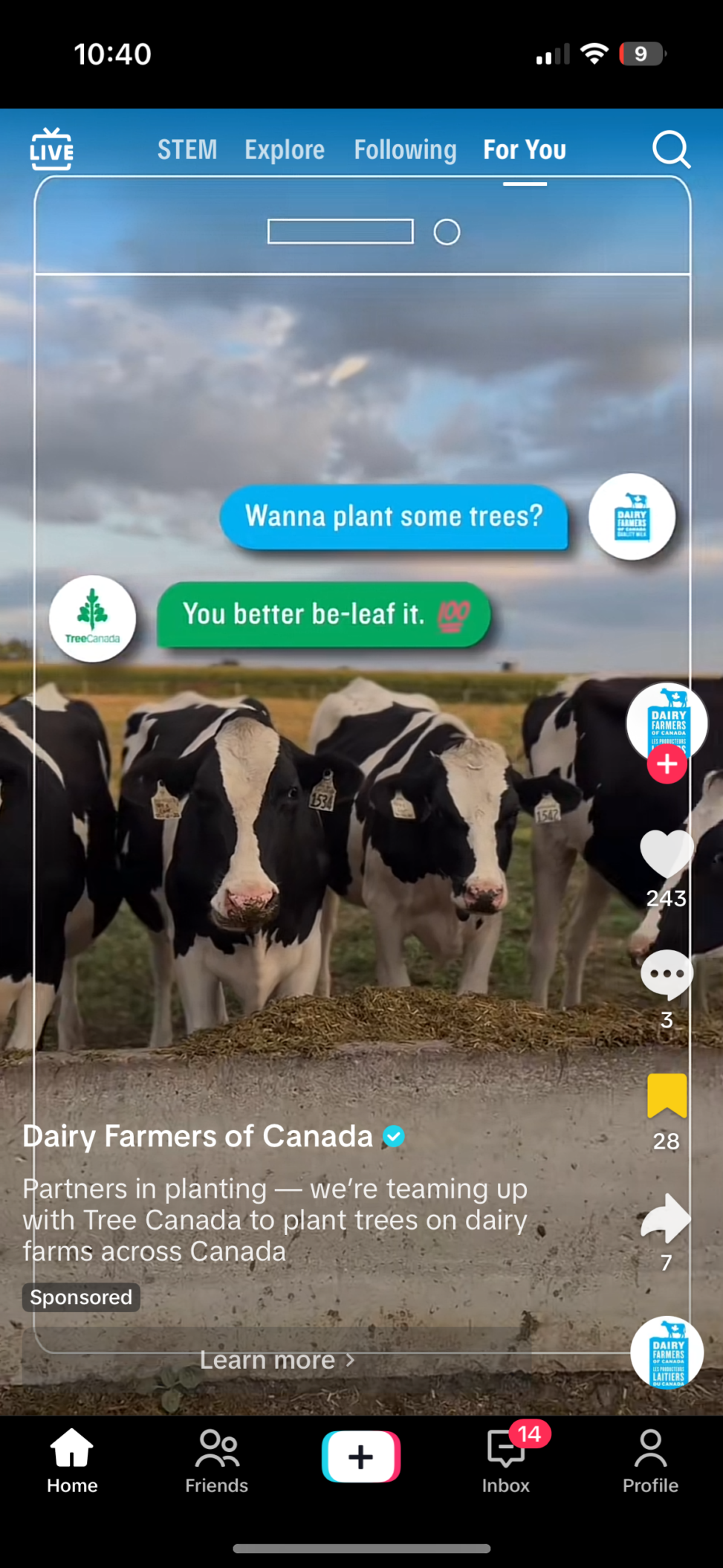Ila Watson
Visa 1500-01
September 30th, 2025
Dairy Farmers of Canada are a nationally known non-profit that works with farmers by farmers. This advertisement came across my TikTok feed, and it caught my attention because Dairy Farmers of Canada are partnering with Tree Canada, another nationally known non-profit based in Canada. Both organizations aim to inform Canadians on the importance of sustainability and responsible practices. The advertisement showcases cows leisurely standing in a pasture making the ad feel calm and easily approachable while also connecting the brand back to its farming roots. A text conversation is displayed above the cows. The text conversation helps appeal to a younger audience who often use text messages as a main channel of communication making it more relatable. The conversation contains the play on words, “You better be-leaf it.” which helps appeal to a younger audience by creating a more casual approach that helps viewers relate to the message. The main colours used in the advertisement are blue and green, which pop against the brown and grey background of the pasture, making your eyes immediately go to the text.
This advertisement is trying to sell the idea that Dairy Farmers of Canada are environmentally conscious and committed to sustainability. Dairy farmers are recognizing that the dairy industry is harsh on the environment because of the carbon emissions milk production releases. Farmers are taking the initiative to reduce their carbon footprint by planting trees on their farms. By collaborating with Tree Canada and planting trees on dairy farms this ad encourages viewers to associate Dairy Farmers of Canada with positive environmental action. This ad builds trust and convinces consumers to have a positive attitude towards supporting Canadian dairy products in the future.
The target audience is clear in the advertisement; their audience is Gen Z and Millennials. This advertisement is currently running on the social media platform TikTok, younger generations are the primary users of this platform. Gen Z and millennials engage better with ads that appear more causal, relatable and contain humour. When advertisements contain these appealing factors, they are more memorable and the younger generations are more likely to engage by commenting, liking and sharing with their friends which gets the advertisement more traffic. Dairy Farmers of Canada took this approach by using a play on words and communicating this information through a text message conversation. Dairy Farmers of Canada hope to encourage their younger views who care about climate change and who want to support companies that use sustainable practices to think about the organizations values while shopping and to choose to support their brand.
Dairy Farmers of Canada’s partnership with Tree Canada aims to shift viewers’ attention away from the environmental concerns often associated with the dairy industry, such as overproduction, to make viewers believe that Dairy Farmers of Canada are an eco-conscious company. Since 2012 6.8 billion litres of Canadian milk products have been disposed of from dairy farms due to over production. This has been calculated to have produced 8.4 million tons of carbon emissions. On average a mature tree absorbs 48lbs of carbon emissions per year, to combat these emissions 382 million trees would need to planted. Dairy Farmers of Canada claim that over 9000 farmers have signed up to plant trees on their dairy farms. One farm was able to plant 600 trees in 2024 . These 9000 farmers would need to plant 42,000 trees per year to make dairy farming sustainable. This does not account for the time it takes for these trees to grow and the emissions that are generated during that period. Tree planting will never be able to compete with the amount of carbon emissions that are being produced.
I felt the advertisement was creative and engaging because of the use of humour and the casual tone making it stand out compared to other advertisements. Dairy Farmers of Canada did a great job at appealing to the younger generations by using effective marketing strategies. I feel the partnership with Tree Canada was a clever way to shift focus away from the larger issues within the dairy industry. Dairy Farmers of Canada are glossing over the issues of overproduction and the creation of unnecessary carbon emissions while advertising sustainability practices. Planting trees on dairy farms does not eliminate the problems of the dairy industry. I felt this advertisement was appealing and memorable, but it is more of an attempt to make Dairy Farmers of Canada brand image better rather than an actual attempt to address environmental concerns within the dairy industry.
Bibliography
Catch Foundation. “How Many Trees Do We Need to Offset Carbon Emissions? A Data Driven Answer.” Catch Foundation. February 14, 2025. https://catchfoundation.in/blogs/how-many-trees-to-offset-carbon-emissions.
Dairy Farmers of Canada. “Partnering with Tree Canada to Plant Trees on Dairy Farms.” Dairy Farmers of Canada. 2025. https://dairyfarmersofcanada.ca/en/sustainability/tree-canada-october-2024
Thomas Elliot. “Over 6 Billion Liters of Canadian Milk Wasted Since 2012.” Ecological Economics. January 2025. https://www.sciencedirect.com/science/article/pii/S0921800924003100#section-cited-by
\


Ileana Lainez
I chose this submission because, first, the ad is highly successful in implementing greenwashing, and second, because the student did an excellent job of describing and highlighting greenwashing in the ad. She clearly outlines how the ad positions Dairy Farmers of Canada as environmentally responsible through their partnership with Tree Canada, the marketing strategies they used to appeal to the intended audience, and the discrepancy between marketing claims and actual sustainability outcomes. Her main points were that the ad description: cows in a calm landscape with green/ blue colors, and a humorous text message style, appealed to their audience on TikTok. The message of the ad is to present the organization as environmentally conscious through its partnership. The main critical points were that the partnership shifts attention away from major environmental issues in the dairy industry, like overproduction and high carbon emissions, and the scale of tree planting is far too small to offset dairy’s emissions, rendering sustainability claims misleading. She uses one real scholarly source: Ecological Economics (Thomas Elliot, 2025 article), and the other sources are great for context but not scholarly. I think she missed more academic sources, as well as a more in-depth description of the ad, including composition and more detailed visual elements. Overall, she did a great job pointing out the company’s ad as major greenwashing and effectively describing it.